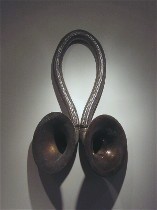 Lucky for me I bumped into artist Terry Adkins (see previous post) when I went back to see his show, “Black Beethoven,” at Pageant, the new gallery on Bainbridge Street (image top, “Behearer”).
Lucky for me I bumped into artist Terry Adkins (see previous post) when I went back to see his show, “Black Beethoven,” at Pageant, the new gallery on Bainbridge Street (image top, “Behearer”).Adkins show is ostensibly about Ludwig von Beethoven and his racial identity, which is somewhat murky (isn’t all racial identity somewhat murky?), but it really was about fabulous object-making, heaven, hell and the human body–including race of course.
While it’s nice to know the historical references–I needed them for only a couple of the pieces. The talismanic pieces like “Veil Isis” and “Appearance” come from a different aesthetic, with Isis the more successful of the two with its burlap bag and glued-on buttons. I appreciated the information about Beethoven’s interest in mystical things Egyptian and Eastern as well as about his notoriously dissheveled appearance. Everything else in the show was elegant and heroic.
 The DVD video, “Dissolve,” a 45 second morph of Beethoven as a white guy to Beethoven as a black guy with dreads and back again is simple without being simplistic. The shifts in skin tone and features are hard to detect as they happen, and only at the extremes are the differences clear–very white European with drooping locks and very brown African with nappy dreadlocks (left). Watching the morph is irresistible and compelling (I watched it more than once).
The DVD video, “Dissolve,” a 45 second morph of Beethoven as a white guy to Beethoven as a black guy with dreads and back again is simple without being simplistic. The shifts in skin tone and features are hard to detect as they happen, and only at the extremes are the differences clear–very white European with drooping locks and very brown African with nappy dreadlocks (left). Watching the morph is irresistible and compelling (I watched it more than once).
The piece is a fine reminder of the truth about race and about all of our racial backgrounds. Beethoven is Adkins and Beethoven is us. (The piece was made with animator Joshua Mosley, who like Adkins, teaches at the University of Pennsylvania.)
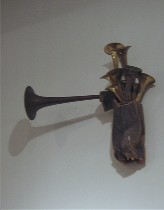 The horn pieces are fabulous fantasies that bring to mind angels in heaven blowing horns to praise the Lord. “I’m trying to make sculpture that’s as ethereal…as music and music as muscular and physical as sculpture,” said Adkins, who also will be performing music at the gallery a couple of times more (on the schedule are “Pinewood Air,” Tuesday, Nov. 23, and “Firmament,” Friday Dec. 17, both at 7:20 p.m.). Some of the horns also imply body parts. “Behearer” (at top) implies ears (top image), as does “Mute,” for example. In this context, even “Jubilee” (right), which suggests bagpipes, also implies human form and function.
The horn pieces are fabulous fantasies that bring to mind angels in heaven blowing horns to praise the Lord. “I’m trying to make sculpture that’s as ethereal…as music and music as muscular and physical as sculpture,” said Adkins, who also will be performing music at the gallery a couple of times more (on the schedule are “Pinewood Air,” Tuesday, Nov. 23, and “Firmament,” Friday Dec. 17, both at 7:20 p.m.). Some of the horns also imply body parts. “Behearer” (at top) implies ears (top image), as does “Mute,” for example. In this context, even “Jubilee” (right), which suggests bagpipes, also implies human form and function.
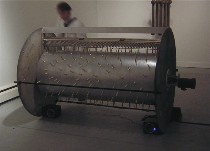 Speaking of muscular, Adkins’ music box, “Off Minor” (left), growls and scratches as it strikes tuning forks. But it’s the look of it, an enormous tube bristling with door-stop springs, that holds interest, looking more like an instrument of torture than an instrument of sound. Or maybe the sound is the torture.
Speaking of muscular, Adkins’ music box, “Off Minor” (left), growls and scratches as it strikes tuning forks. But it’s the look of it, an enormous tube bristling with door-stop springs, that holds interest, looking more like an instrument of torture than an instrument of sound. Or maybe the sound is the torture.
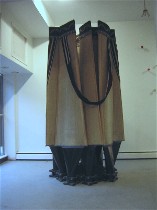 “Plinth,” for holding up an imaginary Beethoven statue, is more about the grandeur he deserves and less about function, it being made of improbably of some kind of propeller material, as well as Napoleonic formal fabrics. Not only is the plinth not a plinth, there being no platform to rest on. It’s a sort of musical instrument, bringing to my mind bag pipes and accordians, bellows and other air squeezers, although that isn’t what Adkins talked about.
“Plinth,” for holding up an imaginary Beethoven statue, is more about the grandeur he deserves and less about function, it being made of improbably of some kind of propeller material, as well as Napoleonic formal fabrics. Not only is the plinth not a plinth, there being no platform to rest on. It’s a sort of musical instrument, bringing to my mind bag pipes and accordians, bellows and other air squeezers, although that isn’t what Adkins talked about.
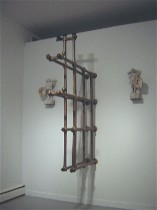
What he did talk about were the geode “ears” in the angels’ hands in “Cathedral” (figures in left image), the ears and eyes of “Earsight,” the unruly appearance of Beethoven in “Appearance” (below right, small piece next to door), and the deafness implied by “Mute,” an array of horn mutes poking from the wall. Between the two angels in “Cathedral” was “Solemnis” (see image), a brass pipe grid that implied the circulatory, nervous and skeletal systems that make our bodies work. The pipes are also a reference to organs and Beethoven’s “Missa Solemnis,” an affirmation of faith.
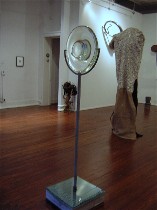
Just fyi, Adkins hung a bunch of contemporaneous portraits of Beethoven that suggest his dark ancestry, and a series of giant lenses, called “Evidence,” are etched at their base with words used to describe Beethoven during his life, including Moor, Espanol, and Swarthy (image right, “Evidence” in center, “Appearance” on floor next to door, and “Veil Isis” covered in buttons right).
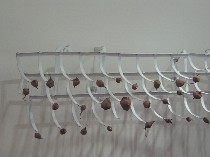
Also fyi, Beethoven means beet harvester which doesn’t really explain “Signature,” the baler with beets on the end (left). The piece, which is white, and which drips beet juice from the impaled beets, shivers if you poke it, and my first response was better the beets than me. If the beets are humans, this is really scary. Anyway, it’s another instrument of torture, like “Off Minor.”
Gallery owner Daniel Dalseth was also there when I stopped by the second time, so I asked him what he had in mind for the future. Dalseth has avant-garde filmmaker Yevgeniy Yufit, from St. Petersburg, Russia, on the schedule so far.
Dalseth, who hails from Minnesota, and came here for his MFA at Penn, where Adkins teaches, is planning shows that remain up for an entire season. Adkins will be up through December. The work is scheduled to go to Dublin and Bonn. I’m not sure in which order or time frame.
If you’re in a rut of visiting the same galleries as usual, this show is a must detour.(The location is a wonderful bonus for us art hogs who now can visit Spector Gallery on the same excursion.
I did just that, catching the end of Spector’s Randall Sellers-Matt Fisher show (see Roberta’s post); the walls were crazy covered with red dots). Pageant is at 607 Bainbridge, 215 925 1535.









